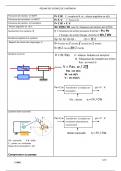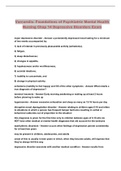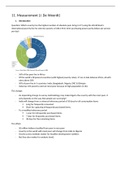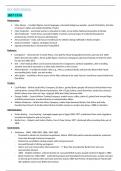The short run
Chapter 3: The Goods Market
3.1 The Compositon of GDP
- Consumpton (C): Goods and services purchased by consumers -> largest component of
GDP.
- Investment (I): Residental (purchase by people of houses or apartmentsh and non-
residental (purchase by frms of new plants or machinesh.
- Government spending (G): Purchases of goods and services by governments.
-> Only purchases no transfers (pensionsh or interest payments on government debt.
- Net export (X-IM): Subtract purchase of foreign goods by domestc consumers and add
purchase of domestc goods by foreign consumers.
-> Trade balance: defcit or surplus.
- Inventory investment: Difference between producton and sales.
3.2 The Demand for Goods
- Z ≡ C + I + G + X – IM -> identty (defnes Zh.
- Simplificatons:
- All frms produce the same good and is willing to supply any amount at a given price (Ph.
- Closed economy: no trade with other countries -> Z ≡ C + I + G.
- C = c0 + c1 (YDh.
-> Behavioural equaton -> behaviour of consumers captured.
-> c0 = Consumpton if disposable income is equal to 0 (consumpton always positveh.
-> c1 = Marginal propensity to consume: Percentage of additonal disposable income that is
consumed (less than 1 and positveh.
-> YD ≡ Y – T -> Disposable income equal to income minus taxes minus government transfers
received by consumers.
- I: Exogenous variable: Not explained in model but taken as given.
-> Endogenous variable: Explained within the model (Ch.
- G: Defnes fscal policy together with T.
-> Exogenous, because no regularity in behaviour government and we want to be able to
determine government behaviour.
3.3 The Determinaton of Equilibrium Output
- This model: Z = c0 + c1 (Y-Th + I + G.
- Assumed frms do not hold inventories -> Y = Z -> Y = c0 + c1(Y-T) + I + G.
-> Producton is equal to demand -> equilibrium conditon.
-> Producton (Yh and income (Yh in equilibrium equal.
- Algebra:
- Y = c0 + c1Y – c1T + I + G.
- (1-c1hY = c0 + I + G – c1T.
- Y = 1/ (1-c1h * (c0 + I + G – c1Th
, -> Equilibrium output -> Producton = Demand.
- (c0 + I + G – c1Th: Autonomous spending -> Part of demand that not depends on output.
-> Positve, unless taxes are much larger than government spending.
- 1/ (1-c1h: Multplier -> multplies the autonomous spending.
-> Greater than 1 as c1 is assumed to be between 0 and 1.
- Graph (P47-48):
- Plot producton as functon of income -> straightforward as Y = Y.
- Plot demand as functon of income: Z = c0 + c1 (Y-Th + I + G = (c0 + I + G – c1Th + c1Y.
-> Intercept vertcal axis: Autonomous spending.
-> Slope of line: Propensity to consume (c1h.
- Equilibrium at intersecton of both lines.
- c0 increases 1 billion -> demand curve shifs up 1 billion.
-> Output (Yh increases with more than 1 billion -> multplier effect.
-> Increase of c0 increases demand tll B -> demand exceeds producton -> producton and
income increased tll C -> demand increases tll D -> producton and income increased tll E ->
can contnue for very long untl limit is reached.
-> AB and BC both 1 billion.
-> CD and DE 1 billion * c1, next round 1 billion * c12, next round 1 billion * c13 etc.
-> Limit equal to: 1 billion * 1/ (1-c1h.
-> Multplier: Sum of successive increases in producton.
- Words:
- Producton depends on demand, which depends on income, which is equal to producton.
- Demand increase -> Producton increase -> Income increase -> demand increase -> etc.
-> increase in output is larger than inital increase in demand.
- Timing of adjustment of output:
- According to assumptons immediately: Producton = Income and producton responds to
demand immediately.
-> Not realistc -> not possible to change producton immediately + consumers might not
change their consumpton straight away afer pay raise.
-> Timing of adjustments depends on producton schedules.
3.4 Investment Equals Savings
- Savings = public savings + private savings.
-> Private savings (Sh = YD – C = Y – T – C.
-> Public savings = T – G.
- Model:
- Y = C + I + G -> subtract taxes.
-Y–T=C+I+G–T
-Y–T–C=I+G–T
-S=I+G–T
- I = S + (T – Gh -> Investment is equal to total savings.
- IS-relaton: Equilibrium conditon -> what frms invest must equal what people and
government save -> another way of looking for equilibrium in goods market.
- Derivaton:
, - S = -c0 + (1 – c1h (Y – Th
-> I = -c0 + (1-c1h (Y-Th + (T – Gh
-> Solve for Y -> Y = 1/ (1-c1h * (c0 + I + G – c1Th
3.5 Is the Government Omnipotent? A Warning
- Government not omnipotent due to restrictons:
- Changing government spending and taxis means natonal parliaments should pass a bill.
- Investment and important will also respond to new G and T.
- Side effects (infatonh.
Chapter 4: Financial Markets I
4.1 The Demand for Money
- How to allocate a given stock of wealth:
- Money: Used for transactons in currency (coinsh and deposit accounts.
- Bonds: Positve interest rate, cannot be used for transactons.
-> Should have both -> proportons based on:
- Level of transactons: You need to have enough money to pay your monthly spending.
- Interest rate: The higher the rate, the more bonds you want.
- Money market funds: Pool funds of people to buy bonds -> pay interest rate slightly below
interest rate they receive (administratve costs and proft marginh.
- Md: demand for money -> sum of individuals and frms demand for money.
-> Md = €YL (-h
-> Demand for money determined by nominal income * decreasing functon of interest.
4.2 Determining the Interest Rate: I
- Assumed only currencies in economy: Supplied by central bank.
- Equilibrium:
- Ms: supply of money: is equal to M.
-> Equilibrium: M = €YL
-> Interest rate should be such that supplied money equals the demand for money given
the nominal income.
-> Increase of nominal income -> increase in demand for money (supply remains constanth
-> interest should increase to compensate shortage of money.
- Monetary policy:
- Money supplied by buying bonds and pay them by creatng money.
-> Expansionary open market operaton: assets (bondsh and liabilites (moneyh increase.
- Decreased by selling bonds and remove received money from circulaton.
-> Contractonary open market operatons: assets and liabilites decrease.
- Interest determined by price bonds (PBh: i = (given payment – PBh / PB
-> The higher the price, the lower the interest rate.
- Other way around: PB = given payment / (1 + ih
-> The higher the interest, the lower the price.
- Expansionary: Increased demand in bonds -> price increases -> interest decreases.











